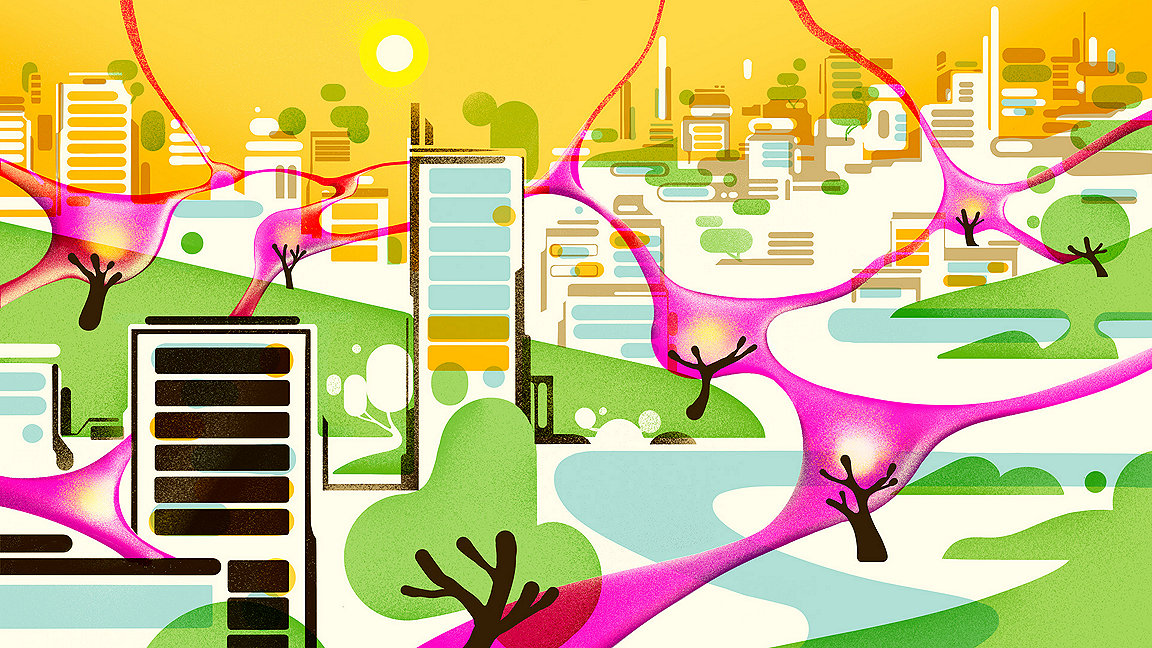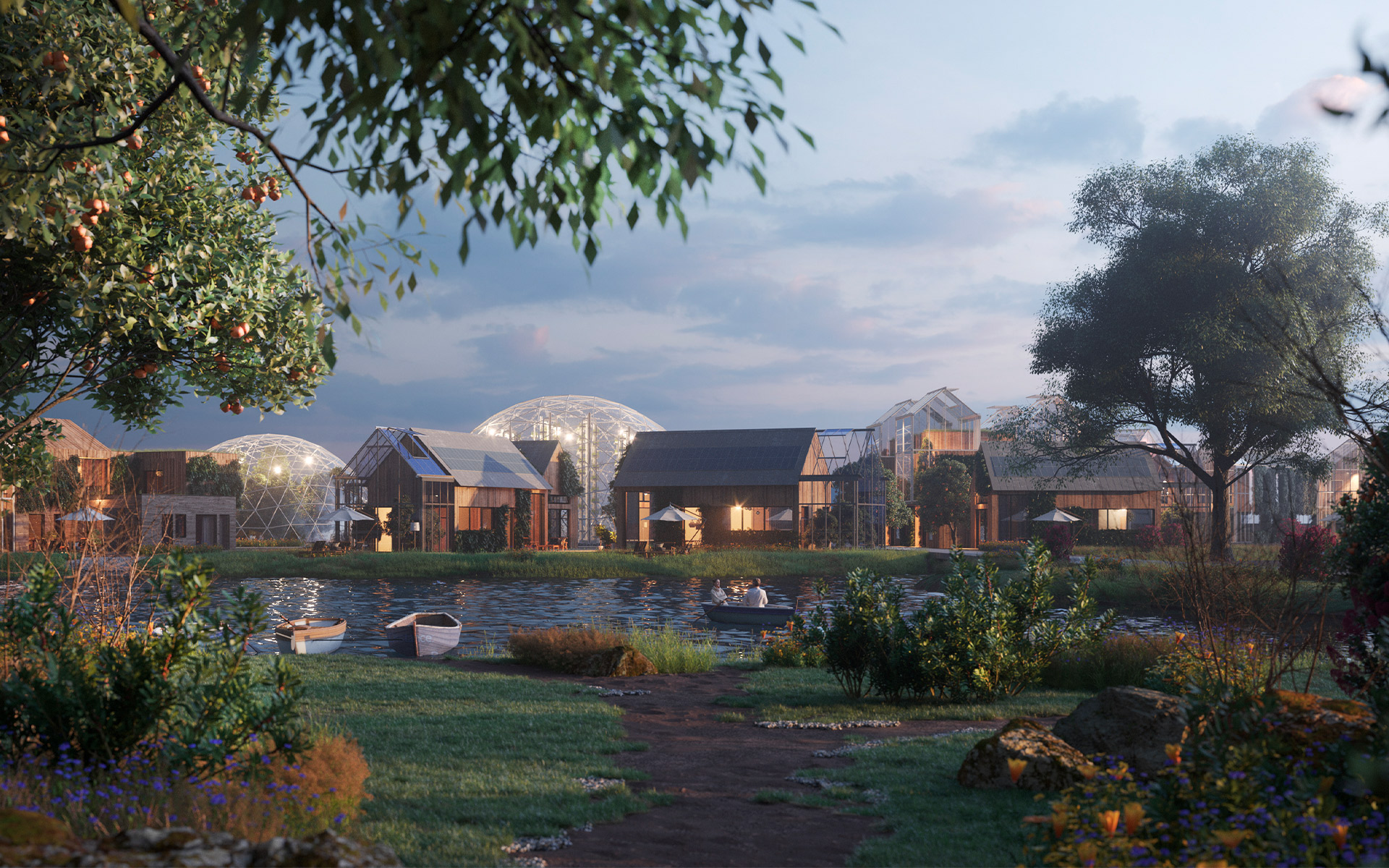
Illustration by Adrià Voltà
Targeted AI and machine learning could be one of the built environment’s biggest weapons in the fight against climate change.
From making building projects more efficient and intelligent, to preserving biodiversity, Modus speaks to two experts in their field who are leading the way with their use of AI focused on sustainability.
“The best use of machine learning is for human and planetary flourishing,” says James Ehrlich. The former video games and special effects designer, who has worked with Hollywood luminaries including Star Wars director George Lucas, is now a lecturer at Stanford University in California, and also the founder of ReGen Villages, an initiative that aims to create communities based on the concept of “regenerative resiliency.”
“We live on a very fragile planet, and one of the biggest offending industries, of course, is the built environment. But our planet can be restored if we take the right steps to do that,” says Ehrlich. When he joined the university in 2012, he was seeking a way in which to connect software to the natural world and became involved in the Solar Decathlon competition to create a high performance, low carbon building. But he soon became convinced that “the foods you can grow, the water you can harvest and all the different things you can do, work better with economies of scale, rather than in a single home context.”
ReGen Villages seeks to apply artificial intelligence and machine learning to integrate high yield organic food, clean water, renewable energy and circular waste-to-resource management at the neighbourhood scale. It combines this with passive house building typologies to create a resilient living infrastructure. “It is a community in which neighbourhoods live within nature, not separate from it. We are not paving over farmland, we are actually producing more artisanal ingredients than would have been there before.”

Rendering of a ReGen village
Underpinning the vision are two pieces of software, the ReGenerative Villages Simulator and VillageOS operating system. Machine learning combines geospatial data about the land on which the community will be built, together with information on inputs such as natural resource flows, demographics, and economics, mimicking the patterns of biological systems, to produce a masterplan. Ehrlich suggests that, for example on a 60-acre greenfield site, it might design a 400-home community with a mix of apartments, row houses, condominiums, and villas. However, two thirds or more of the land would be preserved for biodiverse cultivation, water capture, energy generation, and waste to resource transfer, so that the community can be ‘islanded’, becoming self-sufficient in the case of district level utility failure or disruption.
After the community is established, the software would then act as an adaptive operating system, one that goes far beyond creating a digital twin for facilities management. It is able to model different scenarios – ensuring optimum resource preservation in the face of changing climactic conditions. “I love the idea of waking up with your morning coffee to find your neighbourhood has had a software upgrade,” says Ehrlich.
In addition to creating entirely new communities the software could be employed to design infill developments within cities or provide the blueprint for a resilient “urban overlay”, says Ehrlich: “An example could be to retrofit an existing urban landscape so it is possible to capture water, harvest a certain amount of food and create green spaces that that can influence microclimates.”
The model designs for density sufficient to build regenerative resiliency into the cost of each home, and will be priced for social, affordable, and middle-class budgets, he claims, with communities containing a mixture of rental and owner-occupied properties.
Regen Villages, established as a Netherlands-based company, is raising venture capital funding, and has signed up over 60,000 families through its website to buy or rent homes, says Ehrlich. A first 10,000 resident community is planned in South Africa. “We have lots of outreach around the world, generating opportunities with landowners. We are really excited about expanding the concept globally.”
“The best use of machine learning is for human and planetary flourishing” James Ehrlich, founder of ReGen Villages
The importance of biodiversity as the underpinning for the entire natural world has become increasingly well-understood in recent years, says Zoe Webb. As an ecologist and senior consultant at Arup, her contribution to preserving biodiversity chiefly lies in “being able to truly understand the value that nature brings, and then account for it, when we are looking at developments in particular.”
Her role involves carrying out ecological impact assessments to satisfy the requirements of the UK development planning regime. As part of that process, ecologists need to understand whether there are protected or notable species present within or near to a development site, their population numbers, how frequently they occur, and what the impacts of development would be upon them. Negative effects could involve the loss of a den or resting site, or habitat fragmentation that cuts off natural corridors, disturbing foraging patterns or breeding behaviour.
A key tool to monitor animal behaviour is ‘camera trapping’, using automatic cameras to capture images of wildlife without the disruption that would be caused by having surveyors present on site. The technique, while valuable, has been one of her bugbears for years, admits Webb: “An individual has to spend hours sifting through lots of images, and most of the time, they’re redundant, they’re false triggers, they are just leaves blowing in the wind, or they are not of the target that we that we are looking to assess. You can capture 18,000 images from a two-week period, and if you are camera-trapping for a year, which isn’t unusual with large-scale projects, going through them can be virtually a full-time job.”

A Scottish wildcat hiding in long grass
Webb had developed an interest in the application of digital technology in the ecology sectors. With money from the firm’s internal ‘Invest in Arup’ programme, which is aimed at developing innovative new capabilities, she set the in-house digital team to work on an artificial intelligence programme capable of automatically identifying whether the correct animal appeared within each image.
The software was piloted in 2019 within the Scottish Wildcat enclosure on the Calderglen Country Park to the south of Glasgow. Despite the species’ notorious elusiveness, the AI was able to correctly identify the presence of the cats 99% of the time, “even when it was just a tail sticking out from behind a tree, or where the image quality was so poor that a person couldn’t have seen it,” says Webb.
She believes that the technology could also be applied to other species, such as badgers and otters, or even smaller mammals, like the dormouse. “It could allow us to make a far more accurate assessment of the population, which means that we can provide a far more robust idea of the mitigation that’s needed for a project, because we can understand the impact better. For example, if a road was fragmenting a woodland, we would be better able to understand whether it was a key commuting corridor for the animals.”
It could also be employed for monitoring impact after a project is finished, she observes, providing continuity of data over a period of years, regardless of changes in the project team. With better data will come a more thorough understanding of long-term impacts, and how they can be addressed most effectively.
Webb is currently seeking internal funding to adapt the application to species other than wildcats. It has attracted attention from professionals overseas, she notes: “There has been interest from my colleagues in south east Asia and Australasia to understand how they can deploy it on their ecological products as well. There seems to be a real drive for it, especially for very large schemes. On a 500km new railway for instance, the sheer labour intensiveness of producing robust results on such a large project is a challenge. This is one way of maintaining standards, while also appreciating the value of biodiversity.”
“It could allow us to make a far more accurate assessment of the population” Zoe Webb, senior environmental consultant, Arup
MODUS
TIna Paillet FRICS 02 April 2024